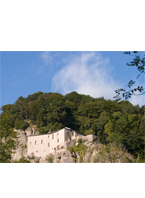CHIUSI DELLA VERNA, CHITIGNANO
From Bibbiena the road leads on towards the Franciscan Shrine of La Verna and on the way you can enjoy one of the Casentino’s greatest riches, the forests. The “Parco Naturale delle Foreste Casentinesi, Monte Falterona, Campigna” was established on 12 July 1993 in order to preserve this wonderful natural environment. With an area of 36,000 hectares, the park extends from just north of Chiusi della Verna to Emilia-Romagna. Driving through the peace and silence of the forest, you reach La Verna, well known for its natural and artistic beauty but, above all, as a place to seek St Francis of Assisi in pilgrimage. In 1213, the saint in all his poverty was given this part of the mountain by Count Orlando Cattani of Chiusi della Verna and, when he arrived here with his companions for the first time in 1214, there were no buildings to shelter them, save a hut made from wood and leaves. However, between 1216 and 1218, the small Chiesetta di Santa Maria degli Angeli had already been built. The building with its portico that you can see today results from a series of reconstructions made necessary, as in the rest of the monastery, by the rigours of the severe winter climate. The church has a single nave and possesses valuable terracotta works from the Della Robbia workshop depicting the Nativity and the Deposition from the Cross, while the Assumption of the Blessed Virgin on the altar is by Andrea della Robbia from about 1490.
In front of this chapel, you will see the old access to the monastery with the ancient road to the village of Beccia and, from here, you go into the Basilica of Our Lady of the Assumption, started after 1348 to fulfil the wishes of the Tarlati Counts of Pietramala, but which was not completed until 1509 when the Florentine corporation of cloth workers, Arte della Lana di Firenze, intervened. The church consists of a single nave with four cross-vaulted bays. It is full of artworks and reliquaries which recall moments in the life of St Francis when he lived here, on the sacred mount of La Verna. Most importantly, there are two shrines in the shape of a baldacchino. The Nativity, on the left, was made in glazed terracotta in 1479 by Andrea della Robbia, the celebrated plastic artist from Florence. He also made the other shrine depicting the Annunciation, in 1476, and Our Lady of Refuge, from 1515-1520, found on the first altar on the right. This work shows he was assisted by other artists from his workshop, whereas in the chapel of the same name, the Ascension, was entirely made by the Master in 1490. The “Cappella delle Reliquie”, or relics, has the important items linking St Francis with La Verna: the table-cloth, the bowl and the glass prepared for him by Count Orlando Cattani, the relic of blood and, in a climate-controlled display case, the Saint’s cowl.
From outside the basilica, you can walk along the Corridor of the Stigmata decorated with frescoes depicting Episodes in the Saint’s Life, painted for the most part by the Florentine artist Baccio Maria Bacci between 1929 and 1963. A number of wonderful places open off from this Corridor, and among these is the cavern where you can see the so-called “bed of St Francis”. After this you pass the entrance to the Hermitage, some other chapels, and reach the Chapel of the Stigmata constructed in 1263 under the direction of Count Simone da Battifolle upon the site where St Francis received, from a seraph, Christ’s wounds on his own body. To recall this event, on the altar there is a glazed terracotta depicting the Crucifixion made by Andrea della Robbia in 1481. There are a good number of places where you can feel the presence of the Saint and his friars and, no less, the care given to the artworks donated by devout followers and found in the sacristy, in the old guest-quarters and in the cloisters, and also in the Museo della Verna where there are a number of very precious paintings even coming from other Franciscan foundations. There ia an Annunciation by Guillaume de Marcillat and a magnificent late 15th-century Crucifix, but above all there are valuable sacred hangings and objects which give you an idea of the life of the Franciscan community over the centuries.
Close to the Museum is the Cappella dell’Adorazione where some detached frescoes are kept. They were painted around 1499 in the Cappella del Beato Giovanni by Domenico Pecori pupil of the painter and architect Bartolomeo della Gatta who, after Piero della Francesca had left the district, was the most important artist working in Arezzo in the second half of the 15th century.
|
|

|
|

